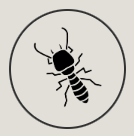What are the signs of termite activity?

Visible muddy trails on the external walls of your property, leading to weep holes or other access points.

Soft spots in your skirting boards and window frames due to termites eating the timber from behind the paint.

Deformation patches in paint work over wooden beams or wooden sections of your property structure.

Large ‘unknown origin’ mould patches in walls or ceiling in the absence of water leaks or humid or wet weather.

Audible “cunching”/”gnawing” noises coming from walls or ceiling particularly noticeable at night.

Audible sound in walls triggers by tapping or knocking on walls caused by termites vibrating defensively.


